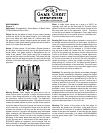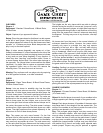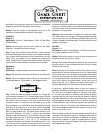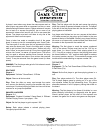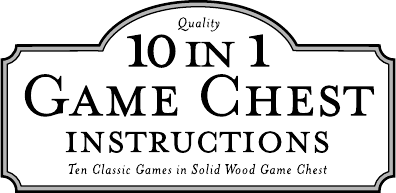
2
3
CHECKERS
Players: 2
Equipment: “Checkers” Game Board, 12 Black Disks,
12 Red Disks
Object: Capture all you opponent’s tokens.
Set-up: Place the game board so that there is a dark square
to the left of each player. Using the black and red tokens,
each player places four tokens on the rst three rows of dark
squares i.e. 12 tokens per player. Black always starts, and
play is only on the dark squares.
Play: A token moves diagonally one square at a time,
forward–not backward. If a token reaches the far side of the
board it becomes a king (stack two playing pieces to indicate
a king) and can now move diagonally in any direction. A
token may also “leap-frog” over another token if there is
a vacant square beyond and if the other token belongs to
the opponent. The jumped token is removed from the board
(captured). If a player fails to capture an opponent’s token
the opponent’s token may on his next turn remove the
offending token. This does not count as his move.
Winning: Play continues until one player wins by capturing
all of his opponent’s tokens, or a draw is declared.
CHESS
Players: 2
Equipment: “Chess” Game Board, 16 Black Chess Pieces,
16 White Chess Pieces
Set-up: Lots are drawn to establish who has the white
chessmen and, thus, who can move rst. This player is then
allotted the 16 white chess pieces and the other player the
16 black chess pieces. The board is positioned so that each
player has a dark corner square on his left. The rooks are
positioned on the two corner squares to the left and right.
Next to these come the two knights, one on the left and
one on the right. Next to these come the two bishops and in
the center, the queen and king. The white queen is always
positioned on a light square and the black queen on a dark
square. The eight pawns are then placed adjacently in the
second row in front of these chess pieces.
Play: The pawns can only move forward. For the rst
advance from its initial square on the second rank, the pawn
has the option of moving one or two squares, but thereafter
may move only one square at a time. The rook moves only
on the ranks and les any distance and the bishop moves
only on the diagonals. The queen can move in any direction.
The knights are the only pieces which are able to change
direction during the course of a move and “jump over” one’s
own or one’s opponent’s pieces; a knight takes one step of
one single square along the le or rank and then, still moving
away from the square that it has left, takes one step along
the diagonal. The king may move in any direction, one step
at a time.
All pieces start from the pawns in the normal direction of
movement described above. However, the pawns which
normally only move in a straight line, may only capture
diagonally to the front, left or right and only while moving
forward. It is not obligatory to capture your opponent. If the
king is threatened, check must be given (the player must
declare check). The opponent is then obliged to protect his
king by moving the king to another square or moving one
or his own pieces between it and the threatening token or
capturing the opposing attacker. If he is unable to make any
of the above moves, the king is said to be checkmated and
the game ends is favor of the opponent.
Castling: Castling is a compound move of the king and one
rook (formally called ’castle‘) that may be made, if at all, only
once in a game. It is legal if neither the king nor the rook
has yet moved. If all the squares between them on the rank
are vacant, and no adverse piece commands two squares
nearest the king on the side on which castling is to be carried
out, and if the king is not in check. The move is executed
by moving the king two squares towards the rook and then
placing the rook on the square passed over by the king.
CHINESE CHECKERS
Players: 2-6
Equipment: “Chinese Checkers” Game Board, 60 Marbles
(10 of each color)
Object: Be the rst player to move all of your marbles to the
triangle opposite your starting triangle on the game board.
Set-up: Each player chooses 10 marbles of the same color
and places them in the triangle of the star nearest him. The
colors of the marbles do not have to match the color of the
point they are placed in, but it is helpful.
Play: The youngest player begins, and play moves to the
left in a clockwise rotation, with each player making one
move at a time. A marble may move in any direction, as long
as it follows the lines of holes on the game board. A player
may jump over a marble, providing there is an empty space
opposite the jumped marble. A player may jump more than
one marble only if there is an empty space opposite each
marble jumped. Players may play as partners or against



